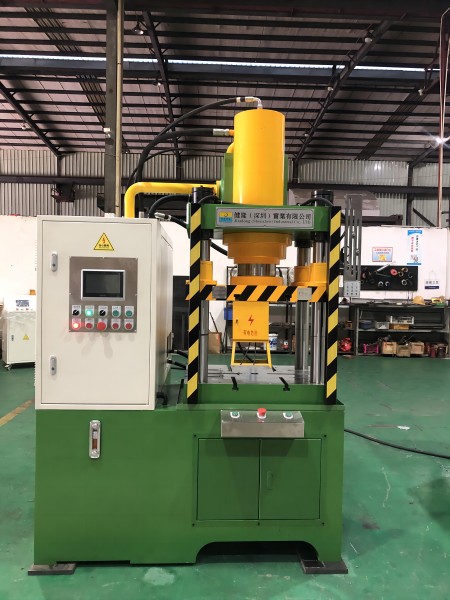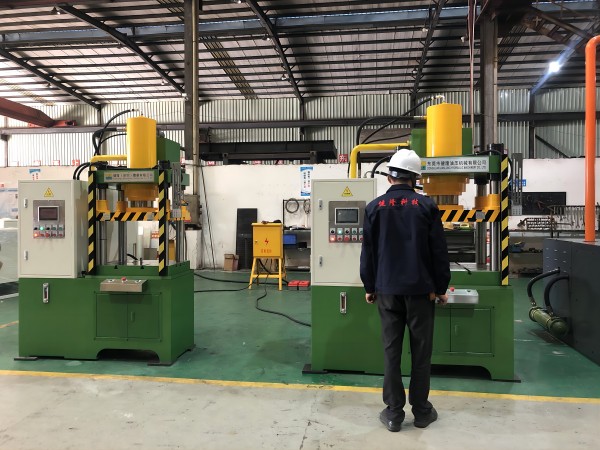As a high-pressure, high-power equipment, the safe operation of hydraulic press is of vital importance. Before the hydraulic press is started, a comprehensive safety inspection must be carried out to ensure safe operation and normal operation of the equipment.

The following is the machine safety start-up testing requirements organized by Jianlong Hydraulic Technology technical team:
1. Equipment appearance and environment inspection
1.1 Equipment appearance: Check whether the appearance of the hydraulic press is intact, and whether the body, console, and operation panel have obvious damage, cracks or deformation.
1.2 Working environment: Ensure that the working environment around the hydraulic press is clean and tidy, without accumulation of debris, and the working area is well ventilated and well lit.
1.3 Fastener inspection: Check whether the fasteners of the hydraulic press, such as bolts and nuts, are loose, and tighten them if necessary.
2. Hydraulic system inspection
2.1 Hydraulic oil: Check whether the oil level of the hydraulic oil in the tank is within the normal range, whether the hydraulic oil is clean and pollution-free, and whether the oil is suitable. If the hydraulic oil is insufficient or contaminated, it should be replenished or replaced in time.
2.2 Hydraulic pipeline: Check whether the hydraulic pipeline has leakage, aging, or damage. Check whether the joints are loose or worn. Ensure that the pipes and joints are tight to avoid leakage.
Filter: Check whether the filter of the hydraulic system is clean. If there is any blockage, it should be cleaned or replaced in time to ensure smooth oil circulation.
2.3 Pressure relief valve: Check whether the pressure relief valve is set within the correct pressure range to ensure normal pressure regulation.
3. Electrical system inspection
3.1 Power cord and grounding: Check whether the power cord is firmly connected and whether it is aging or damaged. Ensure that the hydraulic press is well grounded to avoid static electricity accumulation and electrical failure.
3.2 Control system: Check whether the electrical control box, buttons, switches, and indicator lights are normal, and check whether various electrical protection devices such as leakage protectors are effective.
3.3 Emergency stop button: Ensure that the emergency stop button functions normally and can quickly cut off the power supply in an emergency.
4. Operating system inspection
4.1 Travel limit: Check the upper and lower travel limit switches of the hydraulic press to ensure its sensitivity and accuracy to prevent overtravel operation.
4.2 Lubrication system: Check whether the lubrication system is working properly, whether the lubrication oil circuit is unobstructed, whether the oil volume is sufficient, and whether there is enough grease at the lubrication points.
4.3 Operating device: Check whether the operating handle, foot switch, and button are flexible, without sticking, and whether the action is normal.
5. Safety protection device inspection
5.1 Protective cover and safety baffle: Check whether the protective cover and safety baffle are intact, firm and reliable. Ensure that the safety protection devices in the operating area are working properly.
5.2 Pressure protection: Check whether the pressure protection device of the hydraulic system is working properly to ensure that there is no overpressure danger.
5.3 Emergency stop: Ensure that the emergency stop device can work effectively, is easy to operate, and functions normally.
6. No-load test run
6.1 No-load start: After the inspection is completed, perform no-load test run, observe the working status of the hydraulic press, and ensure that there is no abnormal noise, vibration or oil leakage.
6.2 Check hydraulic action: Under no-load conditions, operate the hydraulic press to move up and down, and check whether its various actions are normal, whether the action is smooth, and without jamming.
6.3 Detect system pressure: Check whether the pressure value of the hydraulic system is within the normal range when it is no-load, and whether the pressure gauge reads accurately.
7. Personnel training and operating specifications
7.1 Operator training: Ensure that operators have received professional training, are familiar with the operating procedures and safety regulations of the hydraulic press, and understand the response measures for emergencies.
7.2 Operating procedures: Operators should strictly follow the operating procedures and must not change the set parameters or operating steps of the hydraulic press without authorization.
8. Preventive maintenance records
8.1 Record inspections: Record the safety inspections before each start-up in the equipment maintenance record sheet, including the problems found and solutions.
8.2 Regular maintenance plan: According to the frequency of use and equipment status, formulate regular maintenance and overhaul plans to ensure the long-term safe operation of the hydraulic press.

Safety inspections before the hydraulic press is started are an important step to ensure the normal operation of the equipment and the safety of the operators. Through comprehensive and detailed inspections, equipment failures and operating accidents can be effectively prevented, and production efficiency and safety can be improved. Operators must follow the above steps to check before starting the machine to ensure that everything is normal before officially operating the hydraulic press.

Contact: Jessie
Phone: 18988729072
E-mail: lifuyan45@gmail.com
Whatsapp:+8618988729072
Add: Guangyi Industrial Park, No.2 Jinfu West Road, Tanglip, Liaobu Town, Dongguan City, Guangdong Province, China
We chat
